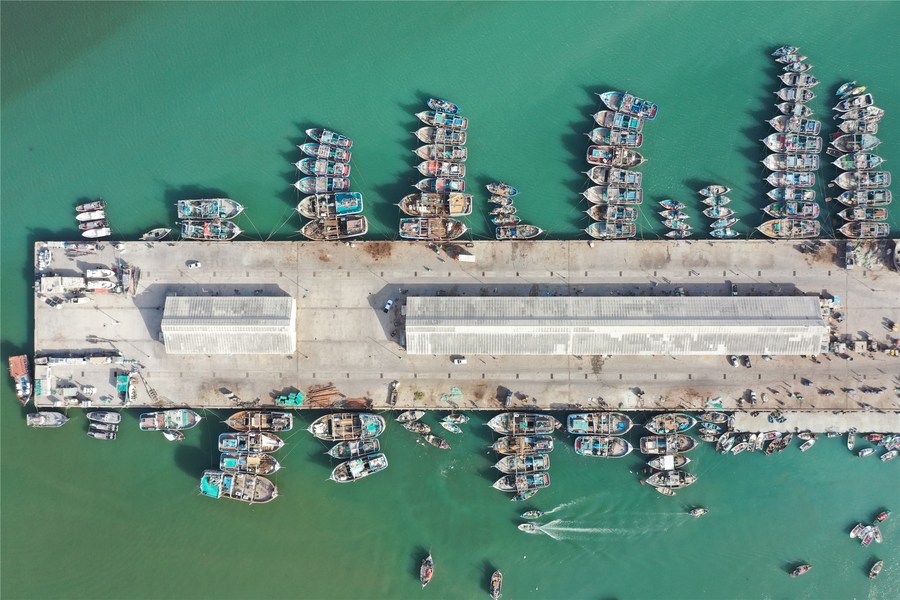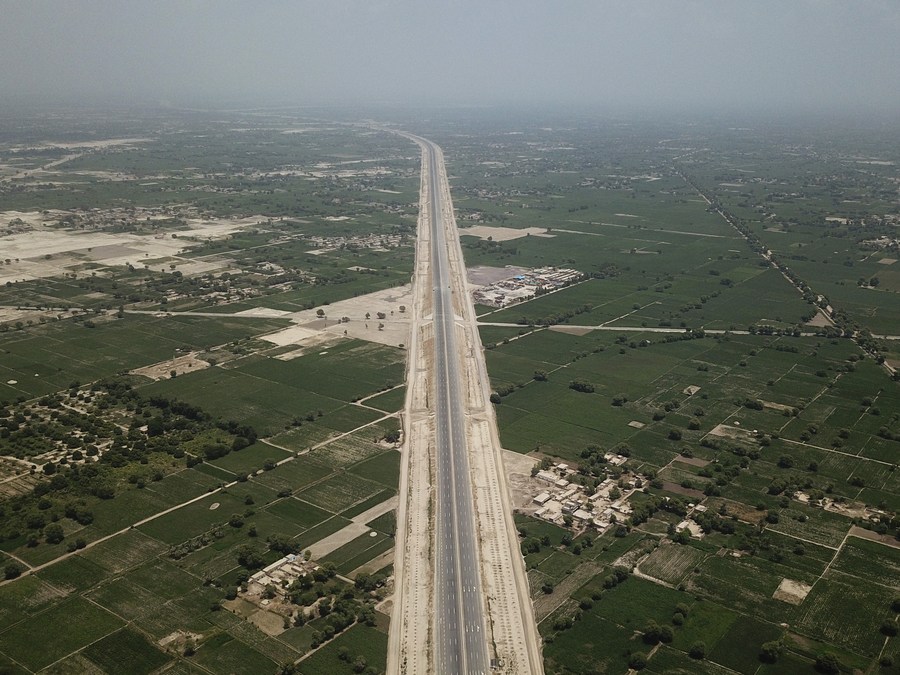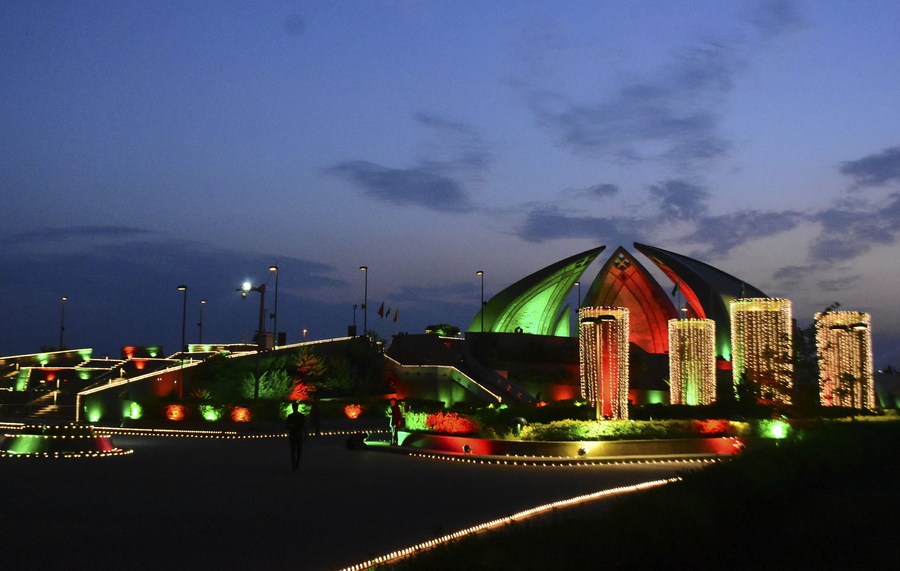Explainer: Why an economic corridor with China has won Pakistan's confidence

This aerial photo taken on Feb. 28, 2023 shows the view of dormitories besides a man-made lake at the Thar Coal Block-I Coal Electricity Integration project in Sindh province, an energy cooperation project under the framework of the China-Pakistan Economic Corridor (CPEC).(Thar Coal Block-I Power Generation Company (Pvt) Limited/Handout via Xinhua)
China and Pakistan have a long history of friendship. In the last decade, China shared its development dividends with Pakistan through the China-Pakistan Economic Corridor (CPEC).
ISLAMABAD, Aug. 3 (Xinhua) -- Pakistani Prime Minister Shahbaz Sharif received a gift, a model of China's self-developed large passenger aircraft C919, when he inaugurated several projects, including the completion of the airside infrastructure at the China-funded New Gwadar International Airport, in the country's southwestern port city of Gwadar last month.
Explaining why he presented the gift to Shahbaz, Ding Kan, manager of the New Gwadar International Airport project management department, told Xinhua, "We strongly believe in the friendship between China and Pakistan. We have built such a good airport for our Pakistani 'iron-clad brother.' We are also looking forward to landing our aircraft in Pakistan at an early date and commencing a new era of cooperation in the civil aviation industry."
China and Pakistan have a long history of friendship. In 2008, Pakistan sent all its tents in stock to earthquake-hit areas in southwest China's Sichuan, while China also rushed to Pakistan's assistance after devastating floods in 2010 and last year. But most significantly, in the last decade, China shared its development dividends with Pakistan through the China-Pakistan Economic Corridor (CPEC).
CHANGING LANDSCAPE
Situated on the Arabian Sea, Gwadar has a warm-water deep-sea port. Although near regional key shipping routes, it had never been involved in the trading network connecting the Middle East, Africa and Europe.
In 2013, Gwadar embraced a new opportunity. The CPEC was launched when no other country was willing to invest in Pakistan. It links the Gwadar port in the south with northwest China's Kashgar in Xinjiang Uyghur Autonomous Region. The Gwadar Port was designated as a key area for development under CPEC in April 2015.

This aerial photo taken on June 4, 2022 shows a port for fishermen in Gwadar of Pakistan's southwest Balochistan Province.(Xinhua/Jiang Chao)
After a decade of development, the Gwadar Port became fully functional and is on its way to becoming a regional hub of connectivity benefiting Pakistan, Afghanistan and Central Asia. Over the past 14 months, the cargo handling at Gwadar Port has consistently increased, with more than 600,000 tons of cargo being handled. Shahbaz stated that the CPEC has brought transformative projects to the Gwadar district.
More than 30 enterprises related to overseas warehouses, fishery products processing, edible oil processing, furniture manufacturing, electric vehicle assembly, trade and logistics, have been settled in the first phase of the Free Zone of the Gwadar Port. In 2021, the Gwadar Technical and Vocational Institute was completed. Now, it provides skill training for 2,000 people yearly for port enterprises.
The overall progress of the New Gwadar International Airport has exceeded 75 percent, said Ding, adding that the runway, apron, contact road and the navigation aid lighting system of the flight area have been completed and have the conditions for flight calibration.
The 19-km-long Gwadar Eastbay Expressway Phase-I has been operating for over a year. The six-lane expressway provides primary connectivity between Gwadar Port and its 2,281-acre Free Zone and facilitates import and export transportation and cargo trans-shipment.
Mir Arshad Kalmati, a resident of Gwadar, has seen the transformation of Gwadar from a fishermen's town to an economic hub over the last few years under the CPEC. "No one can believe how the small colony of Gwadar developed like any major city of Pakistani within a few years. Now we have a good cricket stadium, football grounds, CPEC schools, an airport, a 100-bed hospital and beautiful vast roads."
BACKBONE OF ECONOMIC DEVELOPMENT
Recalling the acute shortage of electricity and up to 18 hours of load shedding in summer in some parts of Pakistan before the CPEC, Zamir Ahmed Awan, the founding chair of Islamabad-based think tank the Global Silk Route Research Alliance, said that the CPEC invested heavily in the electricity sector.
"As a result of the completed power projects, we are producing sufficient electricity to meet current demand in Pakistan," Zamir told Xinhua.
The Karot hydropower plant in Punjab province, the first hydropower project under the CPEC, was fully commercial in June 2022. It has generated 3.64 billion kilowatt-hours in the past year, meeting the electricity demands of more than 5 million residents.
Ahead of the Karot hydropower station, coal-fired power plants under the CPEC, including the Sahiwal coal power plant in Punjab province, the Port Qasim coal power plant in Sindh province and the Hub coal power plant in Balochistan, have addressed the country's severe power shortage. The plants are all eco-friendly and use super-critical technology. Additional facilities are installed to keep emissions well below local and world standards.
Pakistan's Minister for Power, Khurram Dastgir Khan, said the CPEC has enabled the country to gradually shift from imported to locally sourced fuel for power generation. Additionally, there has been a move from outdated to new Chinese technology. "This shift is happening, and Chinese companies are much more visible now. They are bringing their technology and management to Pakistan and teaching Pakistani engineers and workers."
Meanwhile, greatly enhanced connectivity also facilitates logistics and travel in the country. The Karakoram Highway Phase Two project and the Sukkur-Multan Motorway have connected the country's heartland with its remote northern region and financial center in the south.

Arial photo taken on Aug. 5, 2019 shows the view of Sukkur-Multan Motorway in central Pakistan's Multan. (Xinhua/Ahmad Kamal)
According to Shahbaz, CPEC cooperation has dramatically improved the accessibility of roads across Pakistan. The prime minister said the driving distance from Lahore to Karachi has been reduced from more than 20 hours to less than 12 hours, a considerable change.
Improvements in infrastructure, including roads, railways and airports, will not only enhance connectivity within Pakistan but also in the surrounding region and beyond, Badiea Shaukat, an economic consultant at the Sustainable Development Policy Institute, an Islamabad-based think tank, told Xinhua.
He mentioned the CPEC has two benefits. Firstly, it improves trade by reducing costs for local manufacturers. Secondly, it connects Pakistan to neighboring economies, allowing Pakistani exporters to increase trade prospects by reducing export costs.
BENEFIT THE PEOPLE
In 2019, CPEC entered the second phase of high-quality development, focusing on agricultural and industrial cooperation.
In a yard brimming with red chilies strewn everywhere under the blazing summer sun in Kasur district, Punjab province, local farmers were busy ensuring each piece of chili got ample sunlight exposure and dried up in time. The red chili contract farming project started in 2021 under the CPEC, with model farms across Punjab.
This year, Pakistani farmers and laborers are happy to get a bumper harvest of Chinese red chilies and expect good profits as the yield is double that of other varieties of pepper available in Pakistan.
Besides chilies, China is also helping Pakistan with seed cultivation. China helped Pakistan send seven herbal medicine seeds to the Chinese space station via the Shenzhou-14 spaceship last year for space breeding by exposing them to cosmic radiation and microgravity to mutate their genes.
Atia-tul-Wahab, a professor at the University of Karachi's International Center for Chemical and Biological Sciences, said it is the first time that Pakistan sent seeds to space, a landmark achievement for the country. It is hoped that space breeding will enable scientists at her institute to produce medicine for incurable diseases.
"Agriculture, being the backbone of the country, is a high-priority area for us. It witnessed the transfer of Chinese agro-tech to Pakistan, particularly in areas like chili and rice cultivation. The collaboration in agricultural technology has the potential to bring significant benefits to Pakistan's agricultural sector," said Zamir.
The introduction of high-yielding hybrid rice and chili varieties, which are more resilient to local conditions and pests, has contributed to Pakistan's food security and economic prosperity, said Zamir. With China's expertise and advancements in agricultural technology, Pakistani farmers have gained access to modern farming techniques, innovative machinery and improved crop varieties, leading to increased yield and better crop quality.
Earlier this week, a series of celebrations were held. Landmark buildings in Islamabad, the capital of Pakistan, were lit up at night in the colors of the national flags of China and Pakistan to mark the Decade of the China-Pakistan Economic Corridor.

This photo taken on July 29, 2023 shows the Pakistan Monument with a special illumination to celebrate the 10th anniversary of the launch of the China-Pakistan Economic Corridor (CPEC) in Islamabad, capital of Pakistan.(Str/Xinhua)
In a ceremony on Monday, Shahbaz said that the remarkable achievements of the CPEC have profoundly transformed Pakistan's economic and social landscape. He said Pakistan is willing to learn from China's development experience, deepen cooperation with China in various fields, and pursue a path of self-reliance to better benefit the peoples of both countries.
As of 2022, CPEC has brought 25.4 billion U.S. dollars in direct investment to Pakistan and created some 236,000 jobs for the country. Furthermore, according to the Chinese Embassy to Pakistan, it has helped Pakistan generate 8,000 megawatts of electricity, add 886 km to the national core transmission grid and build 510 km of highways.
"It will also bring Pakistan to that stage where it can build its regional connectivity with other Central Asian countries and the Western side of the globe. So, I think that CPEC in real term is a sustainable development model," said economist Shaukat.


